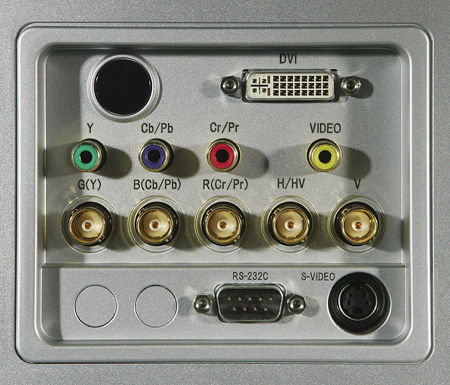Mitsubishi HC2000 front DLP projector

You'd have to go back to the hurricane-plagued CEDIA Expo 1998, in New Orleans, to recall a specific Mitsubishi offering for the home, although that model was a rebranded desktop business projector with major white-balance problems. It never sold particularly well to consumers, and Mitsubishi refocused their efforts on the corporate and educational sectors.
So it was a bit of a surprise—if perhaps inevitable, given the hot home-theater projector marketplace—to see, six years later, two new HT projectors in Mitsubishi's booth at InfoComm 2004. The first, the HC900, was a single-chip DLP design with 1024x576 resolution; the second was the single-chip 1280x720 HC2000. Never one to pass on intrigue, I immediately asked for a review sample of the latter.
When it arrived, I had a recurring feeling of familiarity. Where had I seen this chassis before? Finally, it hit me—I had the same projector set up at my house back in January for my 2004 Super Bowl HDTV Party (see the June 2004 issue for coverage of that event). But back then, it was an Optoma H77!
The H77 was a beta version, and it had some problems recognizing certain video signal formats in my home setup. Even so, it looked promising enough that I returned it to Optoma after the party with a request that a sample ready to review be shipped to me in the near future.
That sample never arrived, but the HC2000 did. C'est la vie. Mitsubishi isn't the first company to rebrand projectors from Taiwan, and they won't be the last.
Out of the Box
This projector actually lives up to Mitsubishi's reputation. The HC2000 isn't a particularly sexy European-style projector—its housing, a rectangular box with no attempt at aerodynamics, is clearly intended to be mounted on the ceiling or hidden away in a floor installation. And at 17.2 pounds, it is emphatically not a coffee-table model. Everything about the HC2000 says "rugged, professional, and functional."
Even the rear panel looks more like what you'd find on a product for commercial installation. It includes the usual RCA composite and S-video jacks, three RCA jacks for Y-Pb-Pr component connections, five BNC jacks (a pleasant surprise) for component-video and RGB signals from set-top receivers and computers, a DVI-I connector for DVI-HDCP and RGB computer signals, and an RS-232 port. There aren't any audio connections because there's no onboard audio amplification or speakers.
The power zoom/focus lens, with a ratio range of 1.58–2.13, includes a manual shift function. Using it, I was able to vertically shift an 80-inch-wide image a total of 46 inches. But most of that shift was below the centerline of the projection lens. The maximum positive vertical shift doesn't place the bottom of the image substantially higher than the top of the projector housing. That's not a problem for a ceiling installation (simply install the projector right side up), but it will be with a floor- or table-level installation, in which the HC2000 will have to be mounted upside down to achieve enough vertical image offset.

The HC2000's imaging engine uses Texas Instruments' HD2+ 1280x720 DMD, powered by a new 250W UHP lamp that Mitsubishi claims will last up to 3000 hours. It's supposed to have more evenly distributed spectral energy for better shading of red, orange, and yellow. The engine is rounded out by a new color wheel with eight segments: RGBRGB sequencing, plus two dark green segments.
The housing, which measures 17 by 5.9 by 12.1 inches, also contains an elaborate cooling system with enough sound baffles to reduce fan noise to 23dBA. I don't attempt to verify noise specs (it requires specialized tools to measure noise levels this low, and in any event can be measured accurately only in an anechoic chamber). I can say the HC2000 was extremely quiet in normal operation, although I did feel lots of hot air being pushed out its side exhaust duct.
Remotes and Menus
The projector's funky-looking, dog-bone remote control has a full complement of transparent, backlit buttons. After some use, I could find my way around it by feel in a darkened room. The menus are easy to navigate and can be placed in four different positions on the screen. They can also be made transparent.
There is direct access to any of the video inputs by name, three user-defined picture memories, six widescreen aspect ratios, and digital image zoom. There are also buttons for direct access to contrast, brightness, tint, color, sharpness, and color temperature. The focus and zoom functions are also accessible from the remote, though you shouldn't have any reason to play with them once the HC2000 is installed and set up.
Picture tweaks can choose from three different gamma settings (Standard, Theater 1 and 2) and play with five different white-balance settings (High Brightness, Special, 6500K, User 1 and 2). In either User mode, you can adjust RGB contrast and brightness, although there's a lot of interaction between these controls.
The HC2000 provides three different choices of black level: 0, +3.75, and +7.5. There's also a White Enhance setting, and a Black Stretch control for boosting or lowering shadow detail.
I found a few quirks with the HC2000 during input selection. The autosync circuitry sometimes skipped right by an active input, and had trouble accepting 1080i and 720p DVI-HDCP sources (more details below).




























































